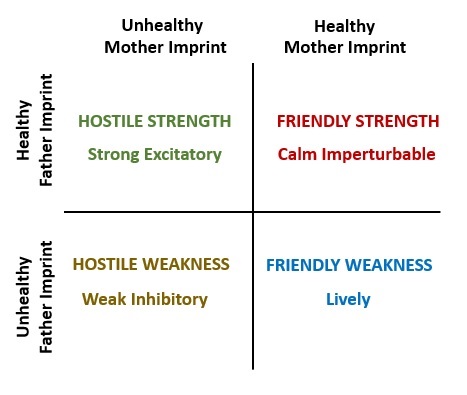Skip ahead
What Are Imprints, Anyway?
I’ve delved deep into the psychology they don’t teach you in any school. Because when I was a teenager, I had terrible anxiety and depression, and the standard psychology industry utterly failed me. You can read more about my story on other parts of the site, but the short version is, a hypnotist cured my decade-long anxiety issue in one hour. One single hour. And ever since I’ve been looking for what really works, and throwing out all the theory and mainstream narratives that don’t produce results.
And in this process I’ve learned some ways to solve problems that many would call miraculous. I can neutralize anxiety and eliminate anxiety disorders; end phobias in a half hour; clear out self-sabotage and imposter syndrome; and neutralize life-long traumas up to and including severe abuse.
But one of the biggest, most impactful understandings I developed was when I was searching for better anxiety cures. Because occasionally I would get a client with a super resistant case of anxiety that just wouldn’t respond the same.
And what I discovered had enormous implications for the health of the human organism, mental and physical.
What was it I discovered?
Imprints.
Now, I discovered them about a decade before I realize their true importance. Because imprints govern how things are set at the nervous system level, which means they are the deepest form of intervention I am currently aware of.
They are so important, that when your imprints are unhealthy, almost everything goes wrong. And when your imprints are healthy, almost everything goes right.
What Is An Imprint?
An imprint is a kind of on/off switch for the nervous system that is set during the life of the individual during a key stage of development. Once set, an imprint is highly resistant to both intellectual and emotional efforts to change it. Learned behavior can be unlearned, deep emotional experiences can be released, but imprints usually persist through the strongest of interventions. They are VERY hard to shift, hard enough that most who identified them considered them inherent or hereditary.
There are at least 8 imprints, but I’m going to focus on the first two: the mother imprint and the father imprint.
A healthy mother imprint means the individual’s nervous system is set such that they feel the world is fundamentally safe, while those with an unhealthy mother imprint have a persistent sense that the world is unsafe. The “runt of the litter” effect we see in dogs and cats is an unhealthy mother imprint on the nervous system of the individual. This is what we find in hypersensitive people, for example certain women who see men as predators by nature. It’s not necessarily the men; it’s those women’s nervous systems that are set at a deep level to experience the world as unsafe because they have unhealthy mother imprints.
A healthy father imprint means the individual’s nervous system is set such that they believe that they can be free and that others can be free, and trade and negotiation are the way to resolve disputes. They have healthy boundaries in all senses of the word. In contrast, an unhealthy father imprint locks people into a paradigm where they are convinced all people are either dominant or submissive. They see the world exclusively in terms of oppressor and oppressed. A good example of this is the group of SJWs, feminists and intersectionalists. They think this way because they have unhealthy father imprints.
How Are Imprints Set?
As the human (or mammalian) nervous system grows, it proceeds through certain sensitivity windows when it expects external feedback in one of two directions. For the first (mother) imprint, this is usually within the first 6 months of life, and relates to the presence of the mother who is able to feed the infant and keep it warm and safe. If, during the sensitivity window, the baby is fed, warm, and safe, that baby’s nervous system is permanently set to experience the world as essentially safe, unles there is a pressing reason for it not to be. Note that this sensitivity window could be as short as an hour - and that there is no way to know when exactly that sensitivity window is active. We know the general age range, but we don’t know exactly when.
The second imprint sensitivity window occurs during the toddler stage, usually somehwere ages 1-3. Again, we cannot tell when the sensitivity window is active, only that it will happen sometime during that age range. This imprint concerns the father’s interaction with the child. If, during the sensitivity window, the father is present, strong, protecting, and providing structure and direction to the situation, the imprint will be healthy. That means the child’s nervous system is permanently set to experience safety and freedom in interactions, feeling secure that Father sets the boundaries within which it is safe to exist. If the father is missing, weak, angry, abusive, or loud during the sensitivity window, the child’s nervous system is permanently set to experience all interactions as one person in charge over another. That child cannot understand human interactions in which both sides are free to negotiate, cooperate, compete, or go their own ways.
It’s important to understand that most people with healthy imprints simply cannot understand the experience of those with an unhealthy imprint and vice versa. Their respective experiences are so different that they don’t overlap.
Now, in addition to imprints, I want to talk about the scientist Ivan Pavlov and psychiatrist William Sargant. Pavlov ran many experiments on the nervous systems of dogs. Pavlov’s famous experiment described how by ringing a bell when delivering food to the dogs, he could later trigger salivation in the dogs by ringing the bell without providing any food. Pavlov discovered that overloading the dogs’ nervous system with various physiological stresses often created periods of increased general suggestibility. He also identified certain stages or thresholds of the nervous system’s ability to manage stresses and what happened when those thresholds were breached.
Fast forward to the 1930s. William Sargant worked with veterans with PTSD, and discovered that by overloading the patient’s nervous system and then providing a dose of barbituates, the patient would go into a catatonic state. When they came out of it, they were free of all the psychosis and all the PTSD.
Why Do Imprints Matter?
Now let me tie it all together. Both Pavlov and Sargant observed that different techniques had different effects on different kinds of subjects. Both dogs and humans could be categorized by their responses. Pavlov immediately recognized that his categories corresponded to the four personality types identified by Hippocrates thousands of years ago – namely bilious, phlegmatic, choleric, and melancholy. Sargant noticed this as well. He wrote that the phlegmatic type of humans required 8 times the dosage of barbiturates to trigger the final nervous system overload and release the PTSD than did the melancholic type. And Pavlov wrote similar things about his dogs – the phlegmatic type required far more intense nervous system disruption to induce the final stages of nervous system overload (what he called the paradoxical and ultra paradoxical effects).
So the first two imprints govern the resilience of the organism at the nervous system level.
The key here, which apparently neither Pavlov nor Sargent knew, is that those four categories are not actually hereditary, they are based on the first 2 imprints, namely the imprints of the mother and the father. The following 2 x 2 grid shows the four possibilities of results for the two imprints. The quadrant names in capital letters are Leary’s; the lower case ones are Pavlov’s.
 The four Hippocratic humors can also be mapped on this chart.
The four Hippocratic humors can also be mapped on this chart.
So we know that imprints matter in terms of nervous system resiliency. But how else do they matter?
You may have heard of attachment style issues. Anxious attachment style is a first imprint issue and can be completely fixed by correcting the mother imprint. Avoidant/hostile attachment style is a second imprint issue and can be completely fixed by correcting the father imrpint. The results I’ve gotten with clients seeking help with attachment issues are some of the most incredible and heartwarming client results I have.
Anxiety issues are often a result of an unehalthy mother imprint because the nervous system feels unsafe and under threat by default. Correcting the mother imprint often fixes anxiety issues.
Victimhood mentality, control issues, people who have been bullied, and people who do the bullying, are all related to father imprint issues. Correcting the father imprint fixes that.
And perhaps most important at the societal level, imprints sort people into political groups. I have never encountered a feminist with a healthy father imprint. Have you ever considered that feminists hate men and see everything in oppressor/oppressed frames? It’s because they all have an unhealthy father imprint. In fact, correcting the father imprint often “cures” feminism!
I go into more detail about the larger societal effects in this blog post here.
Can Imprints Be Changed?
Timothy Leary, the psychiatrist, identified 7 such imprints in humans. He discovered that by using LSD or hallucinogens under the direction of someone to guide things in positive directions, you could revisit and change imprints. He thought that was the only way to get deep enough into the nervous system to change them. (This was also how the ancients fixed imprints - mystery school intiations with hallucinogens and a prescribed drama for the person to go through were explicitly designed to fix imprints).
However, there are pitfalls with working with hallucinogens. For over a dozen clients, I’ve traced the root of a problem to a bad drug trip, which I proceeded to clean up with hypnosis. As far as I can tell, hallucinogens can work - but any issue that is not completely fixed by a drug trip will be made worse.
The good news is that I can correct imprints using hypnosis. And the results have been astounding.
If you think you would benefit from imprint correction, sign up for some sessions and I’ll get your nervous system running the way it was meant to.

Jason Andrews
Jason Andrews is a professional hypnotist and coach who helps clients unlock their minds’ full potential.